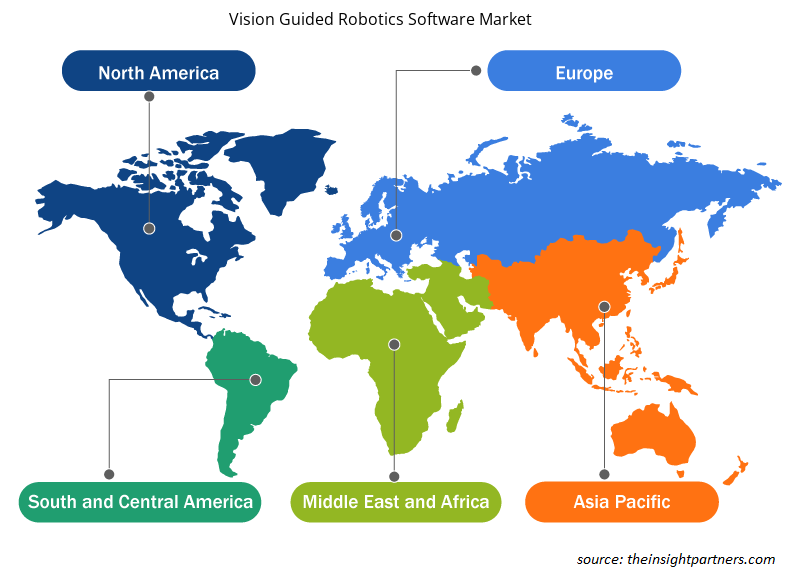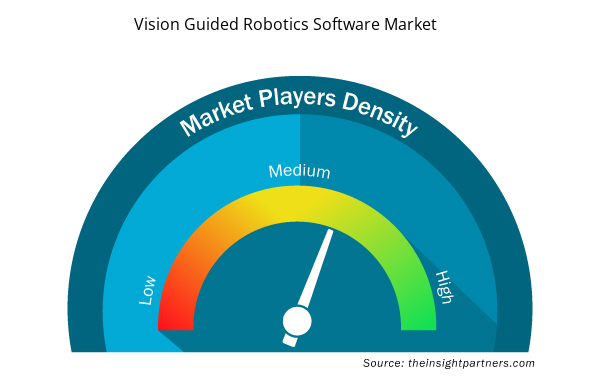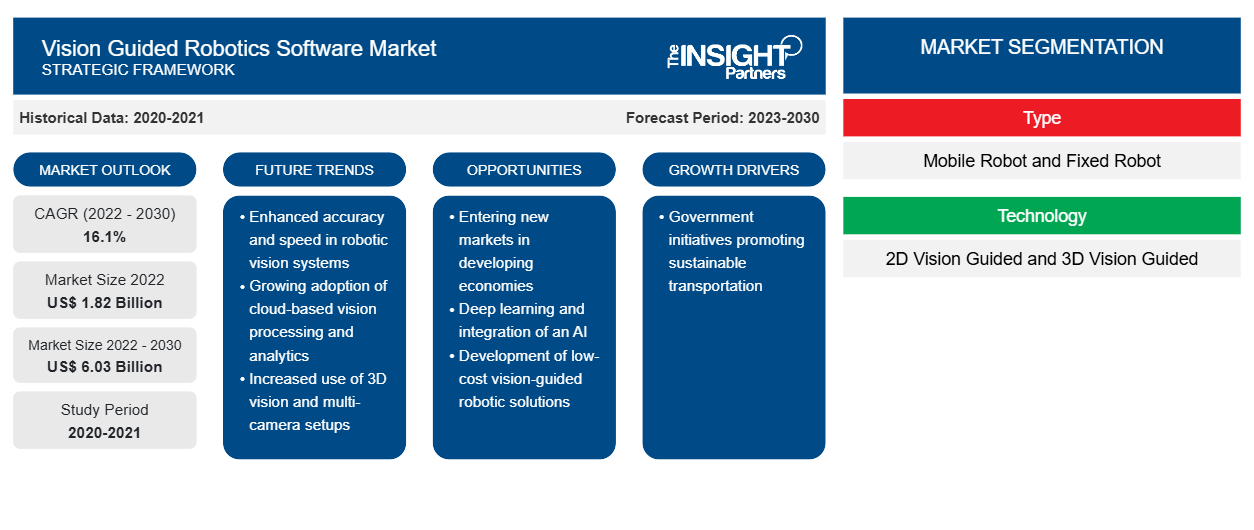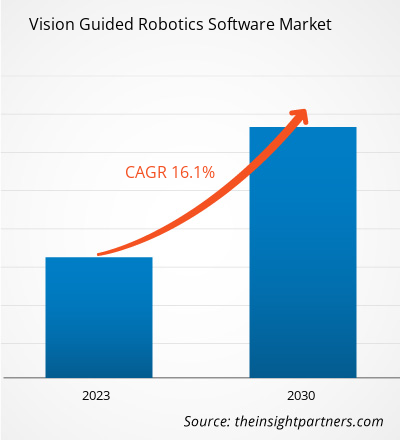[調査レポート] ビジョン誘導ロボットソフトウェア市場は、2022年に18億2,000万米ドルと評価され、2030年までに60億3,000万米ドルに達すると予想されています。また、2022年から2030年にかけて16.1%のCAGRを記録すると予測されています。CAGR of 16.1% from 2022 to 2030.
アナリストの視点:
ビジョンガイドロボットソフトウェア市場は、多数のプレーヤーが存在するため、非常に細分化されています。業界で生き残り、同業他社と競争するために、企業は競争力のある価格、小型化技術、クラウドベースの技術、合併と買収、追加のアフターサービスなど、いくつかの戦略を採用しています。これらの戦略は、企業に他社に対する大きな競争上の優位性を提供します。さまざまな発展途上国の政府が外国直接投資(FDI)を許可し、業界全体で実行される単調で多忙な操作を正確かつ簡単に最適化していることを考えると、ビジョンガイドロボットソフトウェア市場は今後数年間で発展する準備ができています。さらに、エンドユーザーの間で3Dビジョンテクノロジーの需要が急速に高まっており、メーカーはロボットシステム用の堅牢なソフトウェアを革新および開発するよう促しています。3Dビジョンシステムは、RoboRealmやVisionscapeなどのマシンビジョンソフトウェアと組み合わせることで、タスクの実行中にビジョンガイドロボットのパフォーマンスを向上させ、ビジョンガイドロボットソフトウェアの市場シェアを押し上げています。マシン ビジョン ソフトウェアと統合されたビジョン ガイド ロボットは、ピック アンド プレース、ビン ピッキング、溶接、組み立て、ラック、ディスペンシング、製品仕分けなどのアプリケーションに適しています。マシン ビジョン ソフトウェアと組み合わせた 3D ビジョン テクノロジーの利点により、エンド ユーザーは最新のテクノロジーをますます採用しており、ビジョン ガイド ロボット ソフトウェア市場の成長が世界的に促進されています。
市場概要:
ビジョン誘導ロボット ソフトウェアは、さまざまな業界で使用され、特定の製品に関する情報を抽出、特徴付け、解釈し、機械的または電気的に希望する自律タスクを実行します。ビジョン誘導ロボット市場の企業は、自動化シナリオを大幅に強化し、製造業がプロセスを強化するのに役立つ高度なテクノロジの開発に一貫して注力しています。センサー テクノロジと処理能力の進歩により、ロボットは、飛行、運転、移動活動など、ビジョン システムによる障害物回避および識別機能を必要とするより多くのタスクを実行できます。ロボットメーカーが堅牢なビジョン誘導ロボットを開発するための最前線には、イメージング ハードウェアの進歩、急速に増加するコンピューティング能力、高レベル ソフトウェア ライブラリの改善、およびコンピューター メモリのコスト削減が含まれます。また、マシン ビジョンの成長により、産業部門の自動化テクノロジが強化されます。
要件に合わせてレポートをカスタマイズする
このレポートの一部、国レベルの分析、Excelデータパックなど、あらゆるレポートを無料でカスタマイズできます。また、スタートアップや大学向けのお得なオファーや割引もご利用いただけます。
- このレポートの主要な市場動向を入手してください。この無料サンプルには、市場動向から見積もりや予測に至るまでのデータ分析が含まれます。
市場の推進要因:
大量カスタマイズの大きな可能性がビジョンガイドロボットソフトウェア市場の成長を牽引
世界中の大手製造会社は、日々の課題を軽減する目的でインテリジェント テクノロジーを採用しています。組織全体のさまざまな単調な作業向けにカスタマイズされたロボットに対する消費者の需要が高まっており、時間の経過や要件の変化に応じて簡単にアップグレードできます。製品の継続的な機能強化により、何千もの企業が従来の大量生産業者よりも低コストで投資できるようになり、ビジョン ガイド ロボット ソフトウェア市場が活性化しています。ビジョン ガイド ロボット ソフトウェアは、時間の経過とともに消費者の要件に応じて更新できます。このソフトウェア更新は、業界におけるシステムのインストールや新しいシステムの交換よりもユーザーにかかるコストが少なくて済みます。
自動車、航空宇宙、医療、物流、輸送、製造などの業界では、ワークステーションとロボット技術の統合が進んでいます。近年、さまざまなロボット企業が視覚誘導ロボットを開発し、従来のロボットに比べてさまざまな利点があるため、世界的な自動化シナリオに変化が起きています。これらのロボットはマルチタスクが可能で、カメラを搭載しているため、センサー技術の統合が少なくて済みます。ロボットは非常に正確で効率的です。したがって、大量カスタマイズの可能性が高いため、視覚誘導ロボットソフトウェアの市場シェアが拡大しています。
レポートのセグメンテーションと範囲:
ビジョンガイドロボットソフトウェア市場は、タイプ、テクノロジー、アプリケーション、垂直に基づいてセグメント化されています。タイプに基づいて、ビジョンガイドロボットソフトウェア市場は、移動ロボットと固定ロボットに分類されます。テクノロジーの面では、ビジョンガイドロボットソフトウェア市場は、2Dビジョンガイドと3Dビジョンガイドに分類されます。アプリケーションに基づいて、ビジョンガイドロボットソフトウェア市場は、アーク溶接、組み立て、切断、パレタイジングとマシンテンディング、ナビゲーション、ランダムビンピッキング、協働ロボット、その他に分類されます。垂直の面では、市場は自動車、電気および電子、航空宇宙、ヘルスケア、輸送および物流、食品および飲料、その他に分類されます。地域別に、ビジョンガイドロボットソフトウェア市場は、北米、ヨーロッパ、アジア太平洋(APAC)、中東およびアフリカ(MEA)、南米(SAM)に分類されます。
セグメント分析:
タイプに基づいて、ビジョンガイドロボットソフトウェア市場は、モバイルロボットと固定ロボットに分類されます。固定ロボットセグメントは、2022年にビジョンガイドロボットソフトウェア市場のシェアが大きく、予測期間中に成長すると予想されています。固定ロボットは、さまざまな交換可能なツールの利点により、複数の業界で広く使用されています。これらのロボットは、タスクを実行するために十分なプログラミングを必要とし、現在、さまざまなソフトウェア、カメラ、センサーがこれらの自律システムにインストールされて機能を強化しており、セグメントシェアが増加し、ビジョンガイドロボットソフトウェア市場を牽引しています。一般的に、固定ロボットは、溶接、配置、固定、成形などの目的で業界に設置されています。高度な画像システム、センサー、ソフトウェアの助けを借りて、固定ロボットの運用効率が向上し、これらのシステムがタスクを自分で理解できるようになり、ビジョンガイドロボットソフトウェア市場規模が拡大しています。
地域分析:
アジア太平洋地域は、2022年に最大のビジョンガイドロボットソフトウェア市場シェアを占めました。大規模な自動車、半導体、電子機器製造業界の存在により、自動化ロボットの採用が促進され、操作の精度が向上し、ビジョンガイドロボットソフトウェア市場規模が拡大しています。中国と日本には、部品の製造、部品のピックアップと配置、PCB上の小型部品の組み立て、接着剤の塗布、検査、テスト、梱包にビジョンガイドロボットを使用する強力なエレクトロニクス産業があります。アジア太平洋地域は、ビジョンガイドロボットソフトウェア市場の開発と革新を強く推進しています。この地域には、中国、インド、東南アジアなどのいくつかの発展途上国が含まれます。APACは、作業を自動化するためのビジョンガイドロボットソフトウェアの分野で大きな機会を提供し、ビジョンガイドロボットソフトウェア市場を推進しています。数社は、今後数年間でこのソフトウェアをロボットに実装するためのビジョンと戦略を立てています。対照的に、多くの企業は依然として完全に自動化された操作を採用することを計画しており、これがビジョンガイドロボットソフトウェア市場を押し上げると予想されています。
さらに、中国の視覚誘導ロボットソフトウェア市場は成長しています。中国はロボット密度の点で最大の国の1つです。中国の自動車産業におけるロボットの採用は大幅に増加しており、米国とドイツを上回っています。たとえば、国際ロボット連盟によると、中国の製造部門における運用ロボットの数は、2021年に従業員10,000人あたり322台に達し、初めて米国のロボット密度(従業員10,000人あたり274台)を上回りました。また、この地域の多くの国は製造業の中心地であり、この地域に進出する企業の数が増えています。これにより、新しい製造プラントや工場が生まれ、自動化の需要が生まれ、ロボットの設置数が増え、視覚誘導ロボットソフトウェア市場が活性化しています。さらに、電子機器の製造における自動化の需要の増加が、ロボットの設置を促進すると予測されています。これにより、視覚誘導ロボットソフトウェア市場が促進されます。
主要プレーヤー分析:
ABB Ltd、Fanuc Corp、Cognex Corp、OMRON Corp、MVTec Software GmbH、Pick-it NV、Ready Robotics Corporation、Siemens AG、Teradyne Inc、Robotic Vision Technologies (RVT)、LLC は、レポートで紹介されている主要な視覚誘導ロボット ソフトウェア市場プレーヤーの一部です。
ビジョンガイドロボットソフトウェア市場の地域別洞察
予測期間を通じてビジョンガイドロボットソフトウェア市場に影響を与える地域的な傾向と要因は、Insight Partners のアナリストによって徹底的に説明されています。このセクションでは、北米、ヨーロッパ、アジア太平洋、中東およびアフリカ、南米および中米にわたるビジョンガイドロボットソフトウェア市場のセグメントと地理についても説明します。

- ビジョンガイドロボットソフトウェア市場の地域別データを入手
ビジョンガイドロボットソフトウェア市場レポートの範囲
| レポート属性 | 詳細 |
|---|---|
| 2022年の市場規模 | 18億2千万米ドル |
| 2030年までの市場規模 | 60.3億米ドル |
| 世界のCAGR(2022年 - 2030年) | 16.1% |
| 履歴データ | 2020-2021 |
| 予測期間 | 2023-2030 |
| 対象セグメント | タイプ別
|
| 対象地域と国 | 北米
|
| 市場リーダーと主要企業プロフィール |
|
市場プレーヤーの密度:ビジネスダイナミクスへの影響を理解する
ビジョンガイド付きロボットソフトウェア市場は、消費者の嗜好の変化、技術の進歩、製品の利点に対する認識の高まりなどの要因により、エンドユーザーの需要が高まり、急速に成長しています。需要が高まるにつれて、企業は提供内容を拡大し、消費者のニーズを満たすために革新し、新たなトレンドを活用し、市場の成長をさらに促進しています。
市場プレーヤー密度とは、特定の市場または業界内で活動している企業または会社の分布を指します。これは、特定の市場スペースに、その市場規模または総市場価値に対してどれだけの競合相手 (市場プレーヤー) が存在するかを示します。
ビジョンガイドロボットソフトウェア市場で事業を展開している主要企業は次のとおりです。
- ABB株式会社
- ファナック株式会社
- コグネックス株式会社
- オムロン株式会社
- MVTec ソフトウェア GmbH
免責事項:上記の企業は、特定の順序でランク付けされていません。

- ビジョンガイドロボットソフトウェア市場のトップキープレーヤーの概要を入手
最近の動向:
ビジョン誘導ロボット ソフトウェア市場のプレーヤーは、無機戦略と有機戦略を積極的に採用しています。最近の主要な市場動向をいくつか以下に示します。
- 2023 年 12 月、Mecalux (自動倉庫ソリューション、倉庫管理システム、スタッカークレーンの世界的プロバイダー) とシーメンスは、産業オートメーション技術における専門知識と経験を組み合わせました。このパートナーシップにより、新しい人工知能ソリューションを使用して、倉庫と物流センターでのピッキング作業を最適化します。このソリューションは、ソフトウェアと IoT 対応のハードウェア ポートフォリオ、パートナーのエコシステム、およびマーケットプレイスを備えたオープン デジタル ビジネス プラットフォームである Siemens Xcelerator に基づいています。
- 2023 年 11 月、ABB Robotics は、無料の Wizard Easy Programming ソフトウェアの範囲を拡張し、OmniCore コントローラを搭載した 6 軸産業用ロボットと協働ロボットを追加しました。これにより、ABB は、協働ロボットと 6 軸産業用ロボット向けの使いやすいコード不要のプログラミング ツールを提供する初のロボット メーカーとなり、新規ユーザーの自動化の障壁を下げ、エコシステム パートナーとインテグレーターに顧客をサポートするための効率的なツールを提供します。
- 2023 年 8 月、OSARO (e コマース向け機械学習対応ロボットの世界的リーダー) は、顧客に最適な自動化ソリューションを提供する専門知識のエコシステムである OSARO Partners Alliance に Cognex Corporation (産業用マシンビジョンのリーダー) を迎えました。Cognex DataMan 固定マウント型画像ベース バーコード リーダーを OSARO Robotic Bagging System に統合することで、OSARO は Zenni Optical の困難な技術的課題を解決しました。
- ABBは2023年2月、最大11kgの積載能力と、ソリューションにおけるパレタイジングやピックアンドプレースなどの機能を備えた産業用協働ロボット「SWIFTI CRB 1300」をリリースしました。この製品は、産業用ロボットと協働ロボットの間のギャップを埋めるものとして期待されています。
- 過去2年間の分析、基準年、CAGRによる予測(7年間)
- PEST分析とSWOT分析
- 市場規模価値/数量 - 世界、地域、国
- 業界と競争環境
- Excel データセット



Report Coverage
Revenue forecast, Company Analysis, Industry landscape, Growth factors, and Trends

Segment Covered
This text is related
to segments covered.

Regional Scope
North America, Europe, Asia Pacific, Middle East & Africa, South & Central America

Country Scope
This text is related
to country scope.
よくある質問
The global vision guided robotics software market was estimated to be US$ 1.82 billion in 2022 and is expected to grow at a CAGR of 16.1% during the forecast period 2022 - 2030.
Focus on Developing Intuitive Programming is anticipated to play a significant role in the vision guided robotics software market in the coming years.
Integration of Vision-Guided Robots Across Industries and Increasing Need for Automation are the major factors that propel the global vision guided robotics software market.
The key players holding majority shares in the global vision guided robotics software market are ABB Ltd, Fanuc Corp, Cognex Corp, OMRON Corp, MVTec Software GmbH, Pick-it N.V., Ready Robotics Corporation, Siemens AG, Teradyne Inc, Robotic Vision Technologies (RVT), LLC.
The incremental growth expected to be recorded for the vision guided robotics software market during the forecast period is US$ 4.20 billion.
The vision guided robotics software market is expected to reach US$ 6.03 billion by 2030.
Trends and growth analysis reports related to Technology, Media and Telecommunications : READ MORE..
The List of Companies - Vision Guided Robotics Software Market
- ABB Ltd
- Fanuc Corp
- Cognex Corp
- OMRON Corp
- MVTec Software GmbH
- Pick-it N.V.
- Ready Robotics Corporation
- Siemens AG
- Teradyne Inc
- Robotic Vision Technologies (RVT), LLC
The Insight Partners performs research in 4 major stages: Data Collection & Secondary Research, Primary Research, Data Analysis and Data Triangulation & Final Review.
- Data Collection and Secondary Research:
As a market research and consulting firm operating from a decade, we have published and advised several client across the globe. First step for any study will start with an assessment of currently available data and insights from existing reports. Further, historical and current market information is collected from Investor Presentations, Annual Reports, SEC Filings, etc., and other information related to company’s performance and market positioning are gathered from Paid Databases (Factiva, Hoovers, and Reuters) and various other publications available in public domain.
Several associations trade associates, technical forums, institutes, societies and organization are accessed to gain technical as well as market related insights through their publications such as research papers, blogs and press releases related to the studies are referred to get cues about the market. Further, white papers, journals, magazines, and other news articles published in last 3 years are scrutinized and analyzed to understand the current market trends.
- Primary Research:
The primarily interview analysis comprise of data obtained from industry participants interview and answers to survey questions gathered by in-house primary team.
For primary research, interviews are conducted with industry experts/CEOs/Marketing Managers/VPs/Subject Matter Experts from both demand and supply side to get a 360-degree view of the market. The primary team conducts several interviews based on the complexity of the markets to understand the various market trends and dynamics which makes research more credible and precise.
A typical research interview fulfils the following functions:
- Provides first-hand information on the market size, market trends, growth trends, competitive landscape, and outlook
- Validates and strengthens in-house secondary research findings
- Develops the analysis team’s expertise and market understanding
Primary research involves email interactions and telephone interviews for each market, category, segment, and sub-segment across geographies. The participants who typically take part in such a process include, but are not limited to:
- Industry participants: VPs, business development managers, market intelligence managers and national sales managers
- Outside experts: Valuation experts, research analysts and key opinion leaders specializing in the electronics and semiconductor industry.
Below is the breakup of our primary respondents by company, designation, and region:

Once we receive the confirmation from primary research sources or primary respondents, we finalize the base year market estimation and forecast the data as per the macroeconomic and microeconomic factors assessed during data collection.
- Data Analysis:
Once data is validated through both secondary as well as primary respondents, we finalize the market estimations by hypothesis formulation and factor analysis at regional and country level.
- Macro-Economic Factor Analysis:
We analyse macroeconomic indicators such the gross domestic product (GDP), increase in the demand for goods and services across industries, technological advancement, regional economic growth, governmental policies, the influence of COVID-19, PEST analysis, and other aspects. This analysis aids in setting benchmarks for various nations/regions and approximating market splits. Additionally, the general trend of the aforementioned components aid in determining the market's development possibilities.
- Country Level Data:
Various factors that are especially aligned to the country are taken into account to determine the market size for a certain area and country, including the presence of vendors, such as headquarters and offices, the country's GDP, demand patterns, and industry growth. To comprehend the market dynamics for the nation, a number of growth variables, inhibitors, application areas, and current market trends are researched. The aforementioned elements aid in determining the country's overall market's growth potential.
- Company Profile:
The “Table of Contents” is formulated by listing and analyzing more than 25 - 30 companies operating in the market ecosystem across geographies. However, we profile only 10 companies as a standard practice in our syndicate reports. These 10 companies comprise leading, emerging, and regional players. Nonetheless, our analysis is not restricted to the 10 listed companies, we also analyze other companies present in the market to develop a holistic view and understand the prevailing trends. The “Company Profiles” section in the report covers key facts, business description, products & services, financial information, SWOT analysis, and key developments. The financial information presented is extracted from the annual reports and official documents of the publicly listed companies. Upon collecting the information for the sections of respective companies, we verify them via various primary sources and then compile the data in respective company profiles. The company level information helps us in deriving the base number as well as in forecasting the market size.
- Developing Base Number:
Aggregation of sales statistics (2020-2022) and macro-economic factor, and other secondary and primary research insights are utilized to arrive at base number and related market shares for 2022. The data gaps are identified in this step and relevant market data is analyzed, collected from paid primary interviews or databases. On finalizing the base year market size, forecasts are developed on the basis of macro-economic, industry and market growth factors and company level analysis.
- Data Triangulation and Final Review:
The market findings and base year market size calculations are validated from supply as well as demand side. Demand side validations are based on macro-economic factor analysis and benchmarks for respective regions and countries. In case of supply side validations, revenues of major companies are estimated (in case not available) based on industry benchmark, approximate number of employees, product portfolio, and primary interviews revenues are gathered. Further revenue from target product/service segment is assessed to avoid overshooting of market statistics. In case of heavy deviations between supply and demand side values, all thes steps are repeated to achieve synchronization.
We follow an iterative model, wherein we share our research findings with Subject Matter Experts (SME’s) and Key Opinion Leaders (KOLs) until consensus view of the market is not formulated – this model negates any drastic deviation in the opinions of experts. Only validated and universally acceptable research findings are quoted in our reports.
We have important check points that we use to validate our research findings – which we call – data triangulation, where we validate the information, we generate from secondary sources with primary interviews and then we re-validate with our internal data bases and Subject matter experts. This comprehensive model enables us to deliver high quality, reliable data in shortest possible time.


 このレポートの無料サンプルを入手する
このレポートの無料サンプルを入手する